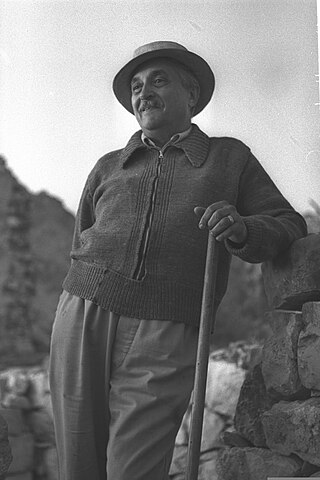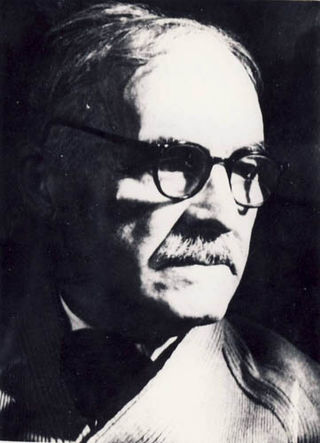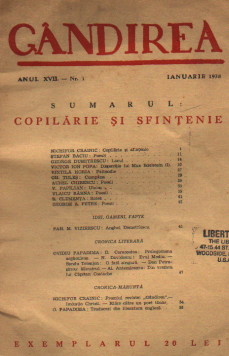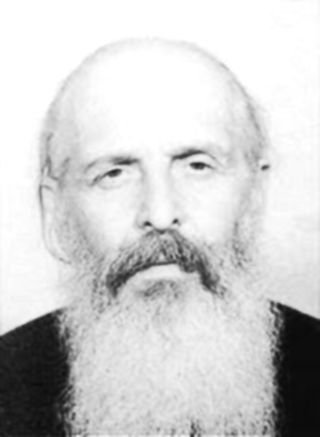Related Research Articles

Marcel Janco was a Romanian and Israeli visual artist, architect and art theorist. He was the co-inventor of Dadaism and a leading exponent of Constructivism in Eastern Europe. In the 1910s, he co-edited, with Ion Vinea and Tristan Tzara, the Romanian art magazine Simbolul. Janco was a practitioner of Art Nouveau, Futurism and Expressionism before contributing his painting and stage design to Tzara's literary Dadaism. He parted with Dada in 1919, when he and painter Hans Arp founded a Constructivist circle, Das Neue Leben.

Ion Nae Theodorescu was a Romanian writer who wrote under the pen name Tudor Arghezi (Romanian pronunciation:[ˈtudorarˈɡezi]. He is best known for his unique contribution to poetry and children's literature.

Tudor Vianu was a Romanian literary critic, art critic, poet, philosopher, academic, and translator. He had a major role on the reception and development of Modernism in Romanian literature and art. He was married to Elena Vianu, herself a literary critic, and was the father of Ion Vianu, a psychiatrist, writer and essayist.

Ilarie Voronca was a Romanian avant-garde poet and essayist.
Sburătorul was a Romanian modernist literary magazine and literary society, established in Bucharest in April 1919. Led by Eugen Lovinescu, the circle was instrumental in developing new trends and styles in Romanian literature, ranging from a new wave of Romanian symbolism to an urban-themed realism and the avant-garde. The review, subtitled Revista literară, artistică şi culturală, was published between April 1919 and May 1921, and again from March 1926 to June 1927.
Milița Petrașcu, also known as Militza Pătrascu, was a Romanian portrait artist and sculptor, part of the Romanian "avant-garde movement" during the interwar period which evolved around the "Contimporanul" magazine. Petrașcu is widely considered as the most talented Romanian woman sculptor of the 20th century.

Scarlat Callimachi or Calimachi was a Romanian journalist, essayist, futurist poet, trade unionist, and communist activist, a member of the Callimachi family of boyar and Phanariote lineage. He is not to be confused with his ancestor, hospodar Scarlat Callimachi.

János Mattis-Teutsch or Máttis-Teutsch, Mátis-Teutsch was a Romanian painter, sculptor, graphic artist, art critic, and poet. Best known for his Seelenblumen ("Soulflowers") cycle of paintings, he was an important contributor to the development of modern art and avant-garde trends inside Romania. He was the grandfather of the artist Waldemar Mattis-Teutsch.

Gândirea, known during its early years as Gândirea Literară - Artistică - Socială, was a Romanian literary, political and art magazine.

Eugen Filotti was a Romanian diplomat, journalist and writer. As a diplomat he worked at the League of Nations in Geneva and then as minister plenipotentiary in Turkey, Greece, Bulgaria, and Hungary. As minister plenipotentiary to Budapest he issued transit visas for Jews during the Holocaust. He was secretary general of the Ministry of Foreign Affairs in 1944–1945. As writer he published several translations of literary works.
Punct was a Romanian art and literary magazine published from 1924 to 1925.

The National University of Arts in Bucharest is a university in Bucharest preparing students in fine arts. The National University of Arts is a higher education institution in Bucharest.

The Symbolist movement in Romania, active during the late 19th and early 20th centuries, marked the development of Romanian culture in both literature and visual arts. Bringing the assimilation of France's Symbolism, Decadence and Parnassianism, it promoted a distinctly urban culture, characterized by cosmopolitanism, Francophilia and endorsement of Westernization, and was generally opposed to either rural themes or patriotic displays in art. Like its Western European counterparts, the movement stood for idealism, sentimentalism or exoticism, alongside a noted interest in spirituality and esotericism, covering on its own the ground between local Romanticism and the emerging modernism of the fin de siècle. Despite such unifying traits, Romanian Symbolism was an eclectic, factionalized and often self-contradictory current.

Ion Theodorescu-Sion was a Romanian painter and draftsman, known for his contributions to modern art and especially for his traditionalist, primitivist, handicraft-inspired and Christian painting. Trained in academic art, initially an Impressionist, he dabbled in various modern styles in the years before World War I. Theodorescu-Sion's palette was interchangeably post-Impressionist, Divisionist, Realist, Symbolist, Synthetist, Fauve or Cubist, but his creation had one major ideological focus: depicting peasant life in its natural setting. In time, Sion contributed to the generational goal of creating a specifically Romanian modern art, located at the intersection of folk tradition, primitivist tendencies borrowed from the West, and 20th-century agrarian politics.

Sandu Tudor was a Romanian poet, journalist, theologian and Orthodox monk. Having had an adventurous youth, he first became known in the late 1920s, when he contributed to the modern Orthodox revival, rallying with the journal Gândirea. Although a traditionalist and a critic of materialism, he was closely associated with the modernist scene, and generally supported left-wing causes. Tudor was also a scandal-prone journalist and newspaper owner, who faced accusations of slander and was avoided by his peers.

Lucian Boz was a Romanian literary critic, essayist, novelist, poet and translator. Raised in Bucharest, he had a lawyer's training but never practiced, instead opting for a career in journalism and literary criticism. An active participant in the 1930s cultural scene, he theorized an empathetic and "enthusiastic" approach to literature, which was in tune with the avant-garde tendencies of his lifetime. After a stint editing the review Ulise in 1932–1933, he became a contributor to more major newspapers, including Adevărul, Cuvântul Liber, and Vremea; he was also for a while an editorial secretary at Ion Vinea's Contimporanul.
Stephan Roll was a Romanian poet, editor, film critic, and communist militant. An autodidact, he played host to the Romanian avant-garde at his father's dairy shop, publishing his work in short-lived reviews and in two volumes of poetry. As one of the editors of the magazine unu, he turned from Constructivism, Futurism and jazz poetry to the more lyrical format of Surrealism. Roll's political radicalism seeped into his avant-garde activity, and produced a split inside the unu group; Roll's faction discarded Surrealism in favor of proletarian literature, and affiliated with the underground Romanian Communist Party.

The Romanian pavilion houses Romania's national representation during the Venice Biennale arts festivals.
Events from the year 1922 in Romania. The year saw the Dealul Spirii Trial and the crowning of King Ferdinand.
References
- Dan Grigorescu, Istoria unei generaţii pierdute: expresioniştii, Ed. Eminescu, Bucharest, 1980
- Eugen Marinescu (ed.), Din presa literară românească (1918-1944), Ed. Albatros, Bucharest, 1986